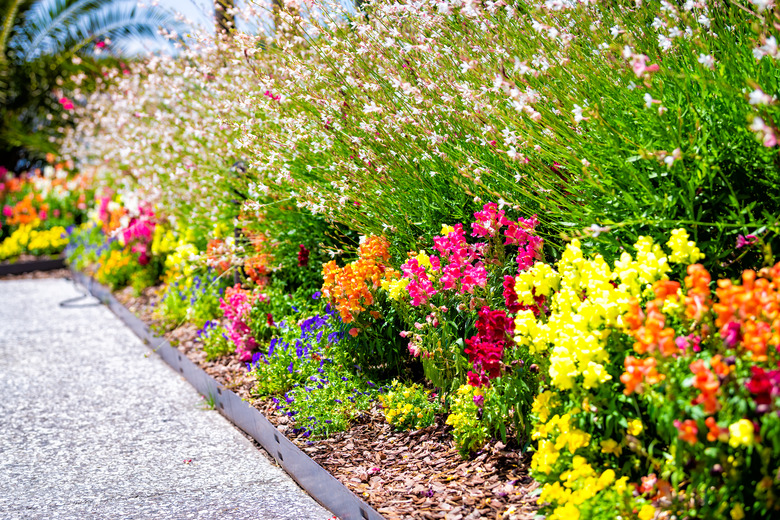How To Keep Snapdragons Blooming All Summer
We may receive a commission on purchases made from links.
Snapdragons (Antirrhinum majus) are tender, cool-season perennials usually grown as annuals. Plant perennial snapdragon seeds in spring for summer color or in late summer and fall for winter flowers in warmer climates. Native to the Mediterranean, snapdragons thrive in U.S. Department of Agriculture plant hardiness zones 7b through 10a. While the familiar, upright flower spikes are available in a wide range of colors, newer cultivars include dwarf and trailing plants suited for containers and small gardens.
About Snapdragon Cultivars
About Snapdragon Cultivars
The two-lipped "dragon head" snapdragon flowers appear on upright stems, with the dark green leaves growing in a spiral pattern on the stem up to the first flower buds. The lowest flower buds open first and the top blossoms last. The flowers may be pastel or bright, solid or bicolored, including white, yellow, orange, pink, red, and purple.
Snapdragons are categorized into three groups: tall at 24 to nearly 48 inches, intermediate at 12 to 24 inches, and dwarf at 8 to 12 inches. There are also trailing cultivars, which grow 6 to 8 inches tall and 12 to 18 inches wide. Plant amid complementary flowering plants as a backdrop or to border walkways and flower beds.
Planting Perennial Snapdragon Seeds
Planting Perennial Snapdragon Seeds
Snapdragon seeds are tiny, so some vendors provide pellets that contain three to five seeds in each pellet. If planting directly in your sunny, well-drained garden bed, amend the soil by digging in 2 to 4 inches of well-decomposed compost and manure. Alternatively, prepare peat pots by filling with seed-starting mix. Because snapdragons require two to three months from germination to flowers, they're often started indoors, six to 12 weeks before the last frost date.
Press the pellets or seeds firmly on top of the moist potting mix or garden soil; they need light to germinate. Cover pots with plastic wrap to help reduce water evaporation from the mix. Keep moist as the seeds germinate, in eight to 14 days. Thin to the strongest seedling by snipping off the extras with sterilized scissors; pinch back when the plant is 3 to 4 inches tall to encourage bushy growth.
Caring for Snapdragons
Caring for Snapdragons
Space snapdragons 6 to 12 inches apart when transplanting into the garden, after daytime temperatures rise above 60 degrees Fahrenheit and nights are above 50 degrees. Whether planting seeds or transplanting seedlings, keep the soil evenly moist but not waterlogged. Snapdragons tend toward rust and fungal diseases, so use soaker hoses or hose end bubblers to keep the soil moist and the foliage dry.
Fertilize existing flowerbeds in spring when growth speeds up with a half-strength solution of a 10-10-10 or 20-20-20 liquid fertilizer or lightly scatter and scratch in a slow-release fertilizer. Water thoroughly after fertilizing. Mulch around the plants to help slow evaporation from the soil and discourage weed seed germination.
The snapdragons may need staking or other support to avoid floppy stems. Two layers of wide-mesh trellis netting can be suspended horizontally over the bed at approximately 4 and 8 inches; allow the snapdragon stems to grow up through the netting, which will support the plants. Raise the top layer or add additional layers of netting as the stems grow taller.
Protecting Snapdragons in Summer
Protecting Snapdragons in Summer
When summer heat arrives, you might ask yourself, "What's wrong with my snapdragons?" Cool-season plants don't do well in summer heat. It may be that it's just too hot for your plants.
Protect your snapdragons by moving potted plants into partial or dappled shade where they receive morning sun but are protected from the hot afternoon sun. Add shade cloth suspended from stakes over snapdragons planted in the garden. Water regularly to keep the roots and plants hydrated.
Deadhead the fading blossoms and cut back plants by one-half or as needed to encourage a fresh flush of flower blossoms. Add a few shovelfuls of compost around the plants or fertilize again with a diluted 10-10-10 or 20-20-20 liquid fertilizer when new growth appears. When temperatures turn cold in late fall or early winter, mulch with a thick layer of straw to protect the roots. Snapdragons are tolerant of colder temperatures and may bloom through the winter in USDA zones 9 and above.
